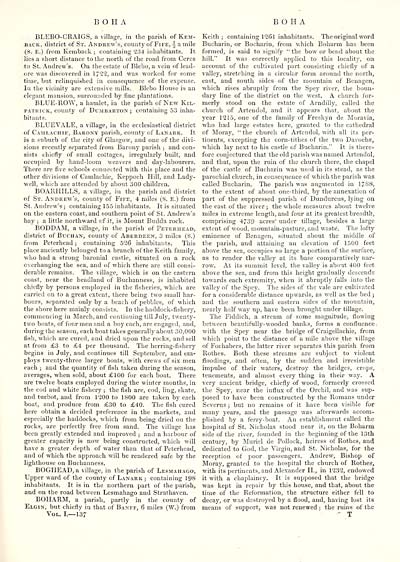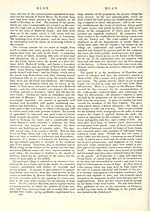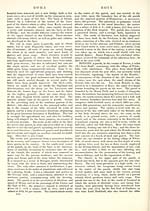Topographical dictionary of Scotland > Volume 1
(151) Page 137
Download files
Complete book:
Individual page:
Thumbnail gallery: Grid view | List view

DOHA
B O H A
BLEBO-CRAIGS, a village, in the parish of Kem-
back, district of St. Andrew's, county of Fife, | a mile
(S. E.) from Kemback ; containing 234 inhabitants. It
lies a short distance to the north of the road from Ceres
to St. Andrew's. On the estate of Blebo, a vein of lead-
ore was discovered in 1/22, and was worked for some
time, but relinquished in consequence of the expense.
In the vicinity are extensive mills. Blebo House is an
elegant mansion, surrounded by fine plantations.
BLUE-ROW, a hamlet, in the parish of New Kil-
patrick, county of Dumbarton ; containing 53 inha-
bitants.
BLUEVALE, a village, in the ecclesiastical district
of Camlachie, Barony parish, county of Lanark. It
is a suburb of the city of Glasgow, and one of the divi-
sions recently separated from Barony parish ; and con-
sists chiefly of small cottages, irregularly built, and
occupied by hand-loom weavers and day-labourers.
There are five schools connected with this place and the
other divisions of Camlachie, Keppoch Hill, and Lady-
well, which are attended by about 300 children.
BOARHILLS, a village, in. the parish and district
of St. Andrew's, county of Fife, 4 miles (S. E.) from
St. Andrew's j containing 155 inhabitants. It is situated
on the eastern coast, and southern point of St. Andrew's
bay ; a little northward of it, is Mount Budda rock.
BODDAM, a village, in the parish of Peterhead,
district of Buchan, county of Aberdeen, 3 miles (S.)
from Peterhead ; containing 596 inhabitants. This
place anciently belonged to a branch of the Keith family,
who had a strong baronial castle, situated on a rock
overhanging the sea, and of which there are still consi-
derable remains. The village, which is on the eastern
coast, near the headland of Buchanness, is inhabited
chiefly by persons employed in the fisheries, which are
carried on to a great extent, there being two small har-
bours, separated only by a beach of pebbles, of which
the shore here mainly consists. In the haddock-fishery,
commencing in March, and continuing till July, twenty-
two boats, of four men and a boy each, are engaged, and,
during the season, each boat takes generally about 30,000
fish, which are cured, and dried upon the rocks, and sell
at from £3 to £4 per thousand. The herring-fishery
begins in July, and continues till September, and em-
ploys twenty-three larger boats, with crews of six men
each ; and the quantity of fish taken during the season,
averages, when sold, about £100 for each boat. There
are twelve boats employed during the winter months, in
the cod and white fishery ; the fish are, cod, ling, skate,
and turbot, and from 1200 to 1S00 are taken by each
boat, and produce from £30 to £40. The fish cured
here obtain a decided preference in the markets, and
especially the haddocks, which from being dried on the
rocks, are perfectly free from sand. The village has
been greatly extended and improved ; and a harbour of
greater capacity is now being constructed, which will
have a greater depth of water than that of Peterhead,
and of which the approach will be rendered safe by the
lighthouse on Buchanness.
BOGHEAD, a village, in the parish of Lesmahago,
Upper ward of the county of Lanark; containing 198
inhabitants. It is in the northern part of the parish,
and on the road between Lesmahago and Strathaven.
BOHARM, a parish, partly in the county of
Elgin, but chiefly in that of Banff, 6 miles (W.) from
Vol. I. — 137
Keith; containing 1261 inhabitants. The original word
Bucharin, or Bocharin, from which Boharm has been
formed, is said to signify " the bow or bend about the
hill." It was correctly applied to this locality, on
account of the cultivated part consisting chiefly of a
valley, stretching in a circular form around the north,
east, and south sides of the mountain of Benagen,
which rises abruptly from the Spey river, the boun-
dary line of the district on the west. A church for-
merly stood on the estate of Arndilly, called the
church of Artendol, and it appears that, about the
year 1215, one of the family of Freskyn de Moravia,
who had large estates here, granted to the cathedral
of Moray, " the church of Artendol, with all its per-
tinents, excepting the corn-tithes of the two Davochs,
which lay next to his castle of Bucharin." It is there-
fore conjectured that the old parish was named Artendol,
and that, upon the ruin of the church there, the chapel
of the castle of Bucharin was used in its stead, as the
parochial church, in consequence of which the parish was
called Bucharin. The parish was augmented in 1/S8,
to the extent of about one-third, by the annexation of
part of the suppressed parish of Dundurcus, lying on
the east of the river ; the whole measures about twelve
miles in extreme length, and four at. its greatest breadth,
comprising 4739 acres' under tillage, besides a large
extent of wood, mountain-pasture, and waste. The lofty
eminence of Benagen, situated about the middle of
the parish, and attaining an elevation of 1500 feet
above the sea, occupies so large a portion of the surface,
as to render the valley at its base comparatively nar-
row. At its summit level, the valley is about 400 feet
above the sea, and from this height gradually descends
towards each extremity, when it abruptly falls into the
valley of the Spey. The sides of the vale are cultivated
for a considerable distance upwards, as well as the bed ;
and the southern and eastern sides of the mountain,
nearly half way up, have been brought under tillage.
The Fiddich, a stream of some magnitude, flowing
between beautifully-wooded banks, forms a confluence
with the Spey near the bridge of Craigellachie, from
which point to the distance of a mile above the village
of Fochabers, the latter river separates this parish from
Rothes. Both these streams are subject to violent
floodings, and often, by the sudden and irresistible
impulse of their waters, destroy the bridges, crops,
tenements, and almost every thing in their way. A
very ancient bridge, chiefly of wood, formerly crossed
the Spey, near the influx of the Orchil, and was sup-
posed to have been constructed by the Romans under
Severus ; but no remains of it have been visible for
many years, and the passage was afterwards accom-
plished by a ferry-boat. An establishment called the
hospital of St. Nicholas stood near it, on the Boharm
side of the river, founded in the beginning of the 13th
century, by Muriel de Pollock, heiress of Rothes, and
dedicated to God, the Virgin, and St. Nicholas, for the
reception of poor passengers. Andrew, Bishop of
Moray, granted to the hospital the church of Rothes,
with its pertinents, and Alexander II., in 1232, endowed
it with a chaplaincy. It is supposed that the bridge
was kept in repair by this house, and that, about the
time of the Reformation, the structure either fell to
decay, or was destroyed by a flood, and, having lost its
means of support, was not renewed ; the ruins of the
" T
B O H A
BLEBO-CRAIGS, a village, in the parish of Kem-
back, district of St. Andrew's, county of Fife, | a mile
(S. E.) from Kemback ; containing 234 inhabitants. It
lies a short distance to the north of the road from Ceres
to St. Andrew's. On the estate of Blebo, a vein of lead-
ore was discovered in 1/22, and was worked for some
time, but relinquished in consequence of the expense.
In the vicinity are extensive mills. Blebo House is an
elegant mansion, surrounded by fine plantations.
BLUE-ROW, a hamlet, in the parish of New Kil-
patrick, county of Dumbarton ; containing 53 inha-
bitants.
BLUEVALE, a village, in the ecclesiastical district
of Camlachie, Barony parish, county of Lanark. It
is a suburb of the city of Glasgow, and one of the divi-
sions recently separated from Barony parish ; and con-
sists chiefly of small cottages, irregularly built, and
occupied by hand-loom weavers and day-labourers.
There are five schools connected with this place and the
other divisions of Camlachie, Keppoch Hill, and Lady-
well, which are attended by about 300 children.
BOARHILLS, a village, in. the parish and district
of St. Andrew's, county of Fife, 4 miles (S. E.) from
St. Andrew's j containing 155 inhabitants. It is situated
on the eastern coast, and southern point of St. Andrew's
bay ; a little northward of it, is Mount Budda rock.
BODDAM, a village, in the parish of Peterhead,
district of Buchan, county of Aberdeen, 3 miles (S.)
from Peterhead ; containing 596 inhabitants. This
place anciently belonged to a branch of the Keith family,
who had a strong baronial castle, situated on a rock
overhanging the sea, and of which there are still consi-
derable remains. The village, which is on the eastern
coast, near the headland of Buchanness, is inhabited
chiefly by persons employed in the fisheries, which are
carried on to a great extent, there being two small har-
bours, separated only by a beach of pebbles, of which
the shore here mainly consists. In the haddock-fishery,
commencing in March, and continuing till July, twenty-
two boats, of four men and a boy each, are engaged, and,
during the season, each boat takes generally about 30,000
fish, which are cured, and dried upon the rocks, and sell
at from £3 to £4 per thousand. The herring-fishery
begins in July, and continues till September, and em-
ploys twenty-three larger boats, with crews of six men
each ; and the quantity of fish taken during the season,
averages, when sold, about £100 for each boat. There
are twelve boats employed during the winter months, in
the cod and white fishery ; the fish are, cod, ling, skate,
and turbot, and from 1200 to 1S00 are taken by each
boat, and produce from £30 to £40. The fish cured
here obtain a decided preference in the markets, and
especially the haddocks, which from being dried on the
rocks, are perfectly free from sand. The village has
been greatly extended and improved ; and a harbour of
greater capacity is now being constructed, which will
have a greater depth of water than that of Peterhead,
and of which the approach will be rendered safe by the
lighthouse on Buchanness.
BOGHEAD, a village, in the parish of Lesmahago,
Upper ward of the county of Lanark; containing 198
inhabitants. It is in the northern part of the parish,
and on the road between Lesmahago and Strathaven.
BOHARM, a parish, partly in the county of
Elgin, but chiefly in that of Banff, 6 miles (W.) from
Vol. I. — 137
Keith; containing 1261 inhabitants. The original word
Bucharin, or Bocharin, from which Boharm has been
formed, is said to signify " the bow or bend about the
hill." It was correctly applied to this locality, on
account of the cultivated part consisting chiefly of a
valley, stretching in a circular form around the north,
east, and south sides of the mountain of Benagen,
which rises abruptly from the Spey river, the boun-
dary line of the district on the west. A church for-
merly stood on the estate of Arndilly, called the
church of Artendol, and it appears that, about the
year 1215, one of the family of Freskyn de Moravia,
who had large estates here, granted to the cathedral
of Moray, " the church of Artendol, with all its per-
tinents, excepting the corn-tithes of the two Davochs,
which lay next to his castle of Bucharin." It is there-
fore conjectured that the old parish was named Artendol,
and that, upon the ruin of the church there, the chapel
of the castle of Bucharin was used in its stead, as the
parochial church, in consequence of which the parish was
called Bucharin. The parish was augmented in 1/S8,
to the extent of about one-third, by the annexation of
part of the suppressed parish of Dundurcus, lying on
the east of the river ; the whole measures about twelve
miles in extreme length, and four at. its greatest breadth,
comprising 4739 acres' under tillage, besides a large
extent of wood, mountain-pasture, and waste. The lofty
eminence of Benagen, situated about the middle of
the parish, and attaining an elevation of 1500 feet
above the sea, occupies so large a portion of the surface,
as to render the valley at its base comparatively nar-
row. At its summit level, the valley is about 400 feet
above the sea, and from this height gradually descends
towards each extremity, when it abruptly falls into the
valley of the Spey. The sides of the vale are cultivated
for a considerable distance upwards, as well as the bed ;
and the southern and eastern sides of the mountain,
nearly half way up, have been brought under tillage.
The Fiddich, a stream of some magnitude, flowing
between beautifully-wooded banks, forms a confluence
with the Spey near the bridge of Craigellachie, from
which point to the distance of a mile above the village
of Fochabers, the latter river separates this parish from
Rothes. Both these streams are subject to violent
floodings, and often, by the sudden and irresistible
impulse of their waters, destroy the bridges, crops,
tenements, and almost every thing in their way. A
very ancient bridge, chiefly of wood, formerly crossed
the Spey, near the influx of the Orchil, and was sup-
posed to have been constructed by the Romans under
Severus ; but no remains of it have been visible for
many years, and the passage was afterwards accom-
plished by a ferry-boat. An establishment called the
hospital of St. Nicholas stood near it, on the Boharm
side of the river, founded in the beginning of the 13th
century, by Muriel de Pollock, heiress of Rothes, and
dedicated to God, the Virgin, and St. Nicholas, for the
reception of poor passengers. Andrew, Bishop of
Moray, granted to the hospital the church of Rothes,
with its pertinents, and Alexander II., in 1232, endowed
it with a chaplaincy. It is supposed that the bridge
was kept in repair by this house, and that, about the
time of the Reformation, the structure either fell to
decay, or was destroyed by a flood, and, having lost its
means of support, was not renewed ; the ruins of the
" T
Set display mode to: Large image | Transcription
Images and transcriptions on this page, including medium image downloads, may be used under the Creative Commons Attribution 4.0 International Licence unless otherwise stated. ![]()
| Gazetteers of Scotland, 1803-1901 > Topographical dictionary of Scotland > Volume 1 > (151) Page 137 |
|---|
| Permanent URL | https://digital.nls.uk/97483846 |
|---|
| Description | Volume I: From Abbey to Jura. |
|---|---|
| Attribution and copyright: |
|

